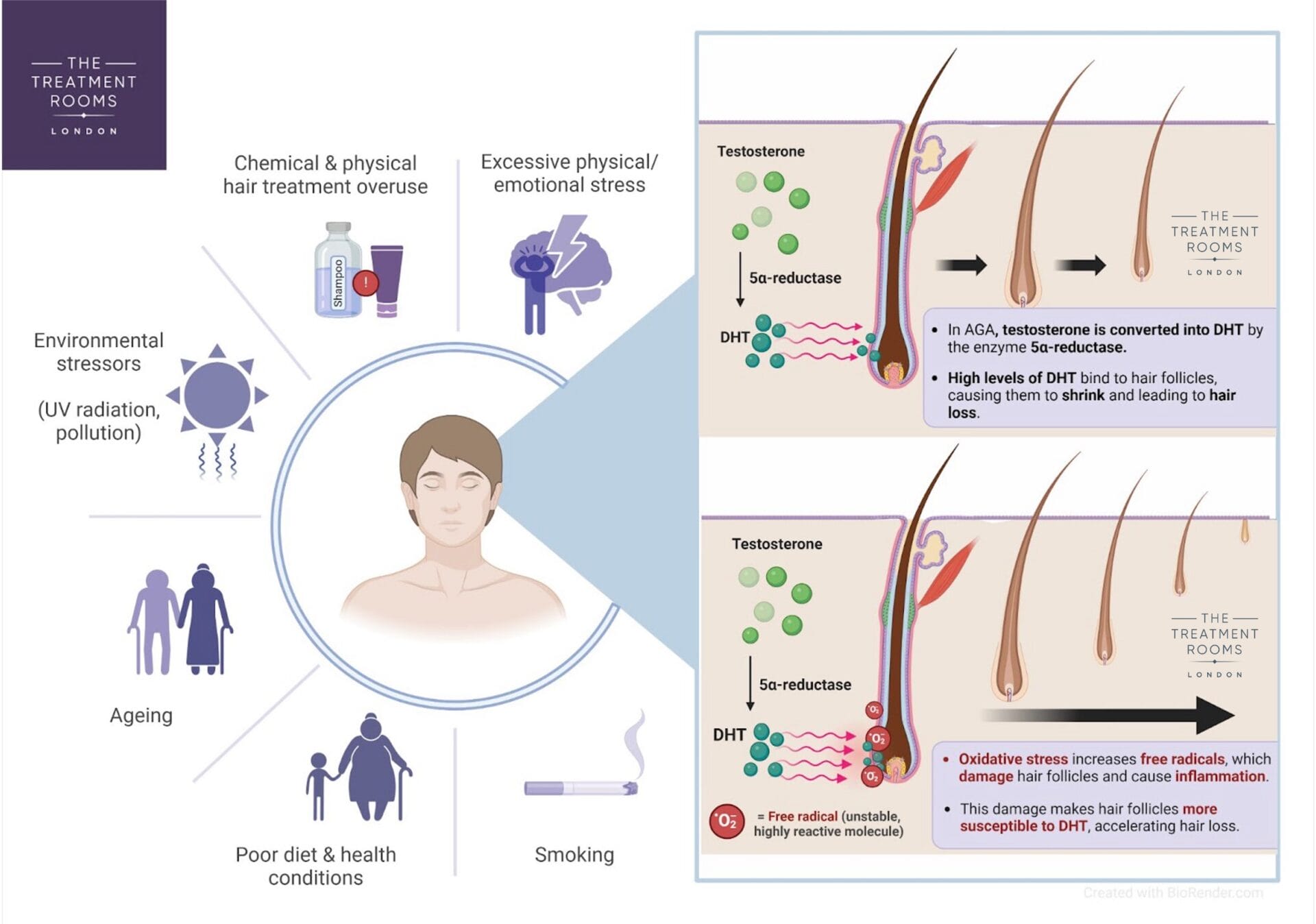Quick Summary: Exercise & Hair Loss
Direct Exercise Factors: Contrary to some myths, the act of physically exercising does not directly cause hair loss. Being active can actually boost scalp health by improving blood flow, nourishing hair follicles for better growth.
Indirect Exercise Factors: While direct exercise-related hair loss is a myth, indirect factors like sweat buildup, nutritional deficiencies, stress from overtraining, and certain supplements can still affect hair health. Simple practices like regular scalp washing, balanced diets, and avoiding tight hair styling help mitigate these effects.
Research Insights: Surveys link intermittent exercise to more hair loss due to possible oxidative stress, while regular training throughout the week might protect against this oxidative stress. This highlights the complex role sustained exercise plays in hair health – and calls for more research to be done on this topic as well.
Key Takeaway: Active lifestyles support your overall well-being and hair health when balanced with mindful hair care and fitness practices. If you’re concerned about significant hair loss, our team at The Treatment Rooms can provide tailored advice and treatment options.
For many, the pursuit of fitness is not just about physical health but also feeling confident and vibrant. However, some wonder if there is a link between their workout intensity and experiencing hair loss. In this article, we delve into whether exercise actually affects your hair, aiming to dispel myths and provide peace of mind to both fitness enthusiasts and those just starting their fitness journey.
The Connection Between Exercise and Hair Health
If you are seeking a quick answer on whether exercise leads to hair loss, the simple response is no—there’s yet to be any solid evidence directly linking exercise to hair loss. In fact, the consensus leans towards the opposite: regular, moderate-to-high intensity exercise enhances blood circulation to your scalp, providing hair follicles with more oxygen and the nutrients they need. This can actually encourage hair to grow healthily and protect against loss.
However, it is worth noting that some aspects of exercise might indirectly influence hair health, but don’t worry, these are generally manageable with straightforward solutions.
Let’s explore some insights from a large survey-based study which discovered a surprising link between exercise intensity and androgenetic alopecia (AGA), the most common type of hair loss. Here’s what they found1:
- Exercise Type and Oxidative Stress : Research suggests that oxidative stress damages hair follicles. This stress is potentially induced by low-intensity exercise and interestingly enough, individuals with AGA were more likely to engage in low-intensity activities like walking for 30 mins/day, compared to those without hair loss.
- Intensity’s Role: Higher intensity exercise didn’t show the same link to AGA. In fact, studies suggest regular moderate-high exercise to be a protective factor against oxidative stress by activating the body’s antioxidant defence mechanisms2, hinting at a complex relationship between exercise and hair health.
- No Direct Cause: Importantly, the study doesn’t claim that low-intensity exercise causes hair loss or that avoiding exercise can prevent it. More research is needed to explore this relationship further.

Addressing The Potential Indirect Links to Hair Loss:
- Sweat and Scalp Care: Intense workouts mean more sweat, which can build up on the scalp and irritate hair roots. A simple fix is to thoroughly wash your hair after intense sweat sessions, allowing natural oils secreted during the workout to do their work for a short while. This approach helps keep your scalp clean without sacrificing the benefits of those natural oils.
- Your Diet: As we’ve emphasised in our blogs, a balanced diet is key to nourishing your hair from the inside out. Pushing hard in your workouts without eating right can leave your hair wanting more. Hair thrives on a diet rich in protein, vitamins, and minerals, so make sure your meals are as balanced as your workout routine to support hair growth.
- Stress and Your Hair: Exercise is great for easing stress, but pushing yourself too hard can have the opposite effect, increasing stress hormones like cortisol and potentially triggering telogen effluvium—a temporary form of hair shedding. Keeping your workout moderate is key.
- Your Workout Hairstyles: Tight hairstyles can strain your hair follicles over time, possibly leading to traction alopecia, a type of hair loss affecting your hairline. Consider looser hairstyles to keep your hairline intact.
- Supplements and Steroids: Seeking that extra edge with supplements or even steroids can backfire when it comes to hair health. These substances aim to build muscle by mimicking male hormones, which can also increase their masculinising effects. These can upset your testosterone levels, and if you’re genetically inclined towards androgenetic alopecia, this will likely speed up hair loss.3,4
Balancing Exercise and Hair Health
Regular exercise is not only safe but beneficial, so we wholeheartedly encourage our readers to embrace an active lifestyle. If concerns about hair health hold you back, rest assured that achieving fitness goals and maintaining hair health goes hand in hand with the right care (as highlighted above).
The NHS provides helpful guidelines on exercise intensity levels to shape your routine. As long as you don’t overdo it, your daily workouts can actually support your journey towards better hair health and overall well-being!
Remember, if you experience significant hair loss, reaching out to your GP or specialists such as our hair transplant clinic is key to identifying the root cause and finding the right treatment. Options could range from medications like Minoxidil or Finasteride to procedures such as hair transplant surgery, depending on your specific needs.
At The Treatment Rooms, we aim to educate our patients with the knowledge on how to balance their lifestyles with good hair care.
Conclusion
The idea that exercise itself leads to hair loss doesn’t hold much weight. Actually, keeping active is good for your overall health and your hair’s health, too. If you take care of the indirect factors that might impact your hair during your fitness journey, you can reap the rewards of being active without fretting over hair loss. Embrace your fitness journey with confidence, knowing that it contributes positively to both your physical and hair health.
References
- Choi, J., Jun, M., Lee, S., Oh, S. S., & Lee, W. S. (2017). The Association between Exercise and Androgenetic Alopecia: A Survey-Based Study. Annals of dermatology, 29(4), 513–516. doi: 10.5021/ad.2017.29.4.513. Available from: https://www.ncbi.nlm.nih.gov/pmc/articles/PMC5500728/
- Parker, L., McGuckin, T. A., & Leicht, A. S. (2014). Influence of exercise intensity on systemic oxidative stress and antioxidant capacity. Clinical physiology and functional imaging, 34(5), 377–383. doi: 10.1111/cpf.12108. Available from: https://pubmed.ncbi.nlm.nih.gov/24283399/
- Singh, M., & Acharya, A. (2021). Overview and Algorithmic Approach to Management of Male and Female Pattern Hair Loss. Indian journal of plastic surgery: official publication of the Association of Plastic Surgeons of India, 54(4), 416–421. doi:10.1055/s-0041-1739256. Available from: https://www.ncbi.nlm.nih.gov/pmc/articles/PMC8719953/
- Pope, H. G., Jr, Wood, R. I., Rogol, A., Nyberg, F., Bowers, L., & Bhasin, S. (2014). Adverse health consequences of performance-enhancing drugs: an Endocrine Society scientific statement. Endocrine reviews, 35(3), 341–375. doi: 10.1210/er.2013-1058. Available from: https://www.ncbi.nlm.nih.gov/pmc/articles/PMC4026349/
- Oxidative stress’s impact on hair follicles illustrated using BioRender.com
Share:
Authored by
Reviewed by
Book a Consultation
Related Blogs
Female Pattern Baldness (Androgenetic Alopecia): Symptoms, Causes & Treatments
July 11, 2025
Female pattern baldness, also known as androgenetic alopecia, is a common genetic condition characterised by hair thinning…
What is DHT & Its Role in Hair Loss?
July 11, 2025
Hair loss is a common concern that millions, if not billions, of people experience at some point…
Complete Guide on Folic Acid and Hair Loss
July 9, 2025
Quick Summary Hair loss is a widespread concern that affects millions of people globally. While genetics, hormonal…
Does Hair Dye Cause Hair Thinning? Understanding the Risks and Facts
July 8, 2025
Have you noticed more hair loss after dyeing your hair? The ingredients in some dyes can be…
When Can You Safely Wear a Beanie After a Hair Transplant?
July 3, 2025
Quick Summary Cap Recommendations: Light, breathable caps, such as snapbacks or trucker hats, are advisable if you need…
Castor Oil (Ricino Oil) for Hair Growth: Benefits, Uses & How to Apply for Maximum Results
June 26, 2025
Castor oil, also known as Ricino oil, is extracted from the Castor bean plant (Ricinus communis). During…
What is a Hair Transplant? How it Works, Success Rate & What to Expect
June 23, 2025
Hair transplantation is a cosmetic surgical procedure that restores hair by moving healthy follicles from one part…
John Cena Hair Transplant
May 14, 2025
John Cena, a common household name, is a figure who has effortlessly straddled the worlds of professional…
Kyle Walker Hair Transplant: Before, After, and His New Hairline
May 12, 2025
Kyle Walker is known for his defensive skills at Tottenham Hotspur, Manchester City, and in the England…











